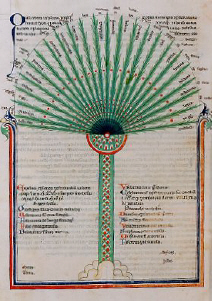Such is the nature of the whole earth, and of the things which are around the earth ; and there are divers regions in the hollows on the face of the globe everywhere, some of them deeper and also wider than that which we inhabit, others deeper and with a narrower opening than ours, and some are shallower and wider ; all have numerous perforations, and passages broad and narrow in the interior of the earth, connecting them with one another ; and there flows into and out of them, as into basins, a vast tide of water, and huge subterranean streams of perennial rivers, and springs hot and cold, and a great fire, and great rivers of fire, and streams of liquid mud, thin or thick (like the rivers of mud in Sicily, and the lava-streams which follow them), and the regions about which they happen to flow are filled up with them. And there is a sort of swing in the interior of the earth which moves all this up and down. Now the swing is in this wise : There is a chasm which is the vastest of them all, and pierces right through the whole earth ; this is that which Homer describes in the words,
“Far off, where is the inmost depth beneath the earth” ; and which he in other places, and many other poets, have called Tartarus. And the swing is caused by the streams flowing into and out of this chasm, and they each have the nature of the soil through which they flow. And the reason why the streams are always flowing in and out is that the watery element has no bed or bottom, and is surging and swinging up and down, and the surrounding wind and air do the same ; they follow the water up and down, hither and thither, over the earth — just as in respiring the air is always in process of inhalation and exhalation ; and the wind swinging with the water in and out produces fearful and irresistible blasts : when the waters retire with a rush into the lower parts of the earth, as they are called, they flow through the earth into those regions, and fill them up as with the alternate motion of a pump, and then when they leave those regions and rush back hither, they again fill the hollows here, and when these are filled, flow through subterranean channels and find their way to their several places, forming seas, and lakes, and rivers, and springs. Thence they again enter the earth, some of them making a long circuit into many lands, others going to few places and those not distant, and again fall into Tartarus, some at a point a good deal lower than that at which they rose, and others not much lower, but all in some degree lower than the point of issue. And some burst forth again on the opposite side, and some on the same side, and some wind round the earth with one or many folds, like the coils of a serpent, and descend as far as they can, but always return and fall into the lake. The rivers on either side can descend only to the center and no further, for to the rivers on both sides the opposite side is a precipice.
Now these rivers are many, and mighty, and diverse, and there are four principal ones, of which the greatest and outermost is that called Oceanus, which flows round the earth in a circle ; and in the opposite direction flows Acheron, which passes under the earth through desert places, into the Acherusian Lake : this is the lake to the shores of which the souls of the many go when they are dead, and after waiting an appointed time, which is to some a longer and to some a shorter time, they are sent back again to be born as animals. The third river rises between the two, and near the place of rising pours into a vast region of fire, and forms a lake larger than the Mediterranean Sea, boiling with water and mud ; and proceeding muddy and turbid, and winding about the earth, comes, among other places, to the extremities of the Acherusian Lake, but mingles not with the waters of the lake, and after making many coils about the earth plunges into Tartarus at a deeper level. This is that Pyriphlegethon, as the stream is called, which throws up jets of fire in all sorts of places. The fourth river goes out on the opposite side, and falls first of all into a wild and savage region, which is all of a dark-blue color, like lapis lazuli ; and this is that river which is called the Stygian River, and falls into and forms the Lake Styx, and after falling into the lake and receiving strange powers in the waters, passes under the earth, winding round in the opposite direction to Pyriphlegethon, and meeting in the Acherusian Lake from the opposite side. And the water of this river too mingles with no other, but flows round in a circle and falls into Tartarus over against Pyriphlegethon, and the name of this river, as the poet says, is Cocytus.
